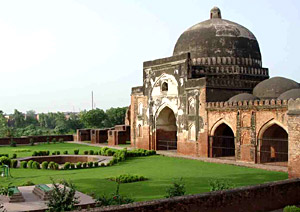Panipat is an ancient and historic city in the state of Haryana and is famous by the name of "City of Weaver". The first verse of the Bhagavad Gita is possibly referencing to Panipat as 'Dharmakshetra'.According to the legend, Panipat was one of the five cities (prasthas) founded by the Pandava brothers during the times of the Mahabharata; its historic name being Panduprastha. Panipat was the scene of three pivotal battles in Indian history.
How to reach here:
By Air : Chandigarh airport is the nearest airport which is 144 kms from Panipat.
By Rail: Panipat railway station is well connected to major cities in India.
Best time to visit: October to March
Languages spoken: Hindi
Must eat: Saag, buttermilk, lassi.
Famous Restaurants: Nirulas, Angeethi, Kohinoor, Big Chef, Big Bytes.
Places you must visit:
Panipat Museum has been especially established for dissminating information about archaeology,
history, art and crafts of Haryana with special emphasis on the Battles of Panipat held in 1526, 1556 and 1761 which marked the turning point in Indian history.It also displays archaeology, history and artefacts of Panipat in the form of antiquities, inscriptions, paintings, sculptures, armoury, pottery, jewellery, art and craft objects, valuable documents, maps, write-ups, and photographs. It also has ceramics of the region of Haryana in the form of clay deposits.

Grave of Ibrahim Lodhi, also popular as Ibrahim Lodhi's Tomb is situated near the Tehsil office of Panipat.Ibrahim Lodhi fought fiercely with his uncle Babur, in the battle known to us today as the "First Battle of Panipat" and was slained and burried at this place. The structure of this grave is a rectangular, one placed on a high platform, which is reachable through steps made of lakhori bricks. The original structure of this tomb has been renovated once by the British Government, in 1866. In this renovation, an inscription mentioning Ibrahim Lodhi’s defeat by Babur was incorporated in the grave.

Tomb of Bu Ali Shah Qalandar, son of Salar Fakirudin was born in 1190 A.D. The Tomb of Bu Ali Shah Qalandar was constructed by the son of Allau-din Khilji, Khizar Khan, about 700 years ago. The premises of this tomb also comprise two other tombs of Hakim Mukaram Khan and Khawaja Altaf Hussain Hali.

Kabuli Bagh was built by Babur after the First battle to commemorate his victory over Ibrahim Lodhi. Some years later when Humayun defeated Salem Shah near Panipat, he added a masonary Platform to it and called it ‘Chabutra" Fateh Mubarak, bearing the inspription 934 Hijri (A.D.1557).

Devi Temple of Panipat exists on the banks of a large tank and is dedicated to a local goddess. This temple is known for its unique architecture and ancient sculptures. Another nearby attraction to this temple includes a Shiva temple known as the Mangal Raghunath. This temple draws its name from a Maratha Ruler, Mangal Raghunath, who built it. This temple survived the battle of Panipat and still exists in the place as a popular pilgrimage destination.

Kala Amb Tree is a popular sightseeing spot of Panipat situated at a distance of 8 km from the city. This tree spot is the place where Sadashiv Rao Bhau located his Maratha troops during the 3rd battle of Panipat. It is a memoir dedicated to the Maratha soldiers, who sacrificed their life in this battle. Kala Amb is a black mango tree, whose dark colour foliage gave it its name.The site has a brick Piller with an iron rod and the structure is surrounded by an iron fence.The site is being developed and beautified by a society with Governor, Haryana as its President.

Shri Ram Sharnam stands as an emblem of supreme devotion to Shri Ram and Selfless service of humanity in the war : ravaged historical city of Panipat. The grace and dignity of its congregation halls and its atmosphare suffused with pity and devotion attract devotees in large numbers.Shri Ram Sharnam Panipat has the honour of being the only prayer hall inaugrated by Swami Satya Nandji himself in 1960, who described it as devinely inspired. swamiji's great desciple Maa Shakuntala Devi and Maa Darshi Devi, the present head of Shri Ram Sharnam have worked with great commitment and devotion to develop it into a singular place for the mental, moral and spiritual advancement of its innumerable devotees.

Salar Gunj Gate is another place of archaeological importance in Panipat. This gate is situated in the middle of Panipat city historical importance to Nawab Salar Juge,the gate still denoting its archacological interest.

Hemu's Samadhi Sthal : After Hemu's beheading at the Camp of Akbar at Saundhapur on Jind Road at Panipat, his head was sent to Kabul to be hanged outside the 'Delhi Darwaza' and his torso was hanged on a gibbet outside Purana Quila in Delhi to terrorise locals. After few years Hemu's supporters, constructed a Samadhi over the place where he was beheaded. The place and its surroundings are slowly encroached upon by local people. This is the only memorial of Hemu in Panipat, but in bad condition.

No comments:
Post a Comment